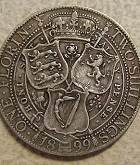
Elizabeth II
Florins were produced for Queen Elizabeth II each year between 1953 and 1967, with proof coins dated 1970. The obverse shows the Mary Gillick head of Queen Elizabeth, inscribed ELIZABETH II DEI GRATIA BRITT OMN REGINA (1953 only) or ELIZABETH II DEI GRATIA REGINA (all other years). This change was made to acknowledge the evolving British Commonwealth, which by then contained some republics. The reverse, by Edgar Fuller and Cecil Thomas, depicts a Tudor rose in the centre surrounded by thistles, shamrocks and leeks, with the Latin phrase FID DEF, the denomination and the date. The designs were selected by the Royal Mint Advisory Committee following a public competition. The artists' initials appear either side of the Welsh leek at the bottom of the reverse. When the reverse of the new coin was illustrated in the press, there was no consensus as to which way was up; numismatist H.W.A. Linecar has noted that the second L in SHILLINGS marks the bottom of the coin.
In accordance with the plan for decimalisation of the currency (120 years after this denomination was first introduced in the initial plan to introduce a decimal currency), from 1968 the ten pence coin was introduced of the same size, weight and metal composition as the florin. Thus, the florin ceased to be struck for circulation after the 1967-dated pieces. The new and the old circulated side by side as florins prior to Decimal Day (15 February 1971) and as ten pence pieces after.
Florins (usually dated 1947 or later) remained in circulation after Decimal Day. In 1987, following a study of the currency, the Thatcher government announced its intent to issue a new ten pence piece, reduced in size. A smaller ten pence piece was issued in 1992, after which the old florin was demonetised on 30 June 1993. The florin, the first decimal coin, was the last coin in general circulation just prior to decimalisation to be withdrawn.